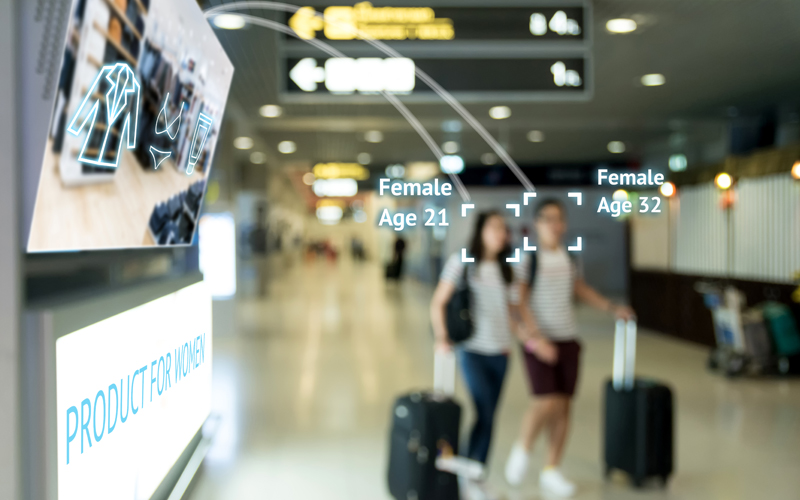Five digital signage trends for 2023
We follow on from our healthcare and manufacturing ‘Top trends of 2023’ feature by taking a closer look at the digital signage sector and sharing what your business should be looking out for this year.
Demand for digital signage is continuing to grow and experts predict the sector will be worth more than £36 billion by 2026, but what are the driving factors behind this?
In this blog we discuss five trends that we expect to be at the forefront of the sector in 2023.
1. Interactivity – better engagement and data analytics
There will be major growth in the use of interactive and touch based displays in 2023. Users will be able to interact much more productively with content, making navigation through menus and options far easier. In a retail setting this can be extended to making purchases directly from the screen with no need for human interaction.
In healthcare we will see an increased level of digital transformation in problem areas like patient registration in primary and secondary care. Implementing interactive kiosks in a GP surgery or outpatients department will allow patients to self-check-in with the right medical practitioner. This will cut down the administrative tasks for receptionists who are currently overworked and under resourced.
2. Personalised Content – set to become the norm and getting smarter
Feeding digital signage with information from external sensors, software can help retail brands to target customers more effectively. And by doing so, they will be able to push advertising content specific to the customer’s profile rather than serving a broad demographic. Sensors have the technology to categorise viewers by age, gender or appearance and deliver smart content to fit the audience viewing the signage. This can then be followed up with a call to action, which could be anything from a prompt to visit a URL to interaction with a social media campaign.
2023 will see the incorporation of mobile technology into this process, enhancing frictionless purchasing and brand engagement. Brands will encourage users to interact with content via QR codes or information sent directly to their smartphones.
3. Content Triggers -changing response to a changing environment
Brands can also look to further enhance the relevance of their advertising with the use of content triggers based on real-time variables. Whether you’re a retailer, corporate enterprise or in the public sector digital signage software such as NowSignage can be programmed to change content based on demographics like age, location and environmental factors such as weather or pollution levels. Additionally, the software’s integration with a weather API can activate triggers in response to a change in conditions, advertise cold drinks during the summer months or coats and scarves when the temperature drops helping you to populate content where it matters.
4. AI, Data Collection and Security-Artificial intelligence and automation to transform analytics
Smart technology continues to improve operational efficiency and help organisations to further scale their business. AI technology when employed in a manufacturing setting, can complete the repetitive and time-consuming tasks that previously needed to be performed by staff. This leaves skilled and time-poor workers free to complete more cognitively challenging tasks. Additionally, AI can gauge the wear and tear on components in machines on the factory floor. By highlighting this and prompting replacements, AI can both improve downtime and productivity.
Touchless technology such as voice activated self-service kiosks will also prove invaluable for data collection. In retail for example, products can be tracked and monitored, and data analysed all the way from the distribution centre to right up to the store helping organisations to gain a better understanding of customer behaviour. The higher the quality of data, the more informed an organisation will be. Retail managers could use data to analyse footfall and trends such as the peak times and most popular searched items. This data could be used to plan staffing or to manage stock levels to meet the predicted demand and reduce the likelihood of over or underordering. Whereas in healthcare, data can be used to predict peak demand times and waiting times and alter timetables accordingly or bring in alternative practitioners like practice nurses or physiotherapists to spread the load.
5. Reducing Carbon Footprint -remote management and low power consumption
Organisations are under increasing regulatory and consumer pressure to reduce their carbon footprint. And with energy prices at an all-time high there is a strong economic imperative to reduce the cost of powering displays and signage. Two key trends will play a prominent role in both of these areas: remote signage management and energy efficient displays. With products like the Nexcom NDiS B560 Digital Signage Player, there is no need to drive across the country to update a display; you can programme it from anywhere with an internet connection. So an agile business decision like a last minute promotion can be actioned without incurring a cost in travel or carbon emissions.
Many businesses will benefit from digital signage with built-in media players as they use less electricity and report lower energy consumption, making them a sustainable and cost-effective solution. Customers are also starting to look for display products that won’t need replacing every two years. The long life cycle of displays plays a role in improving sustainability credentials.
Click here to learn more about how Distec’s digital signage solutions can support your business.

